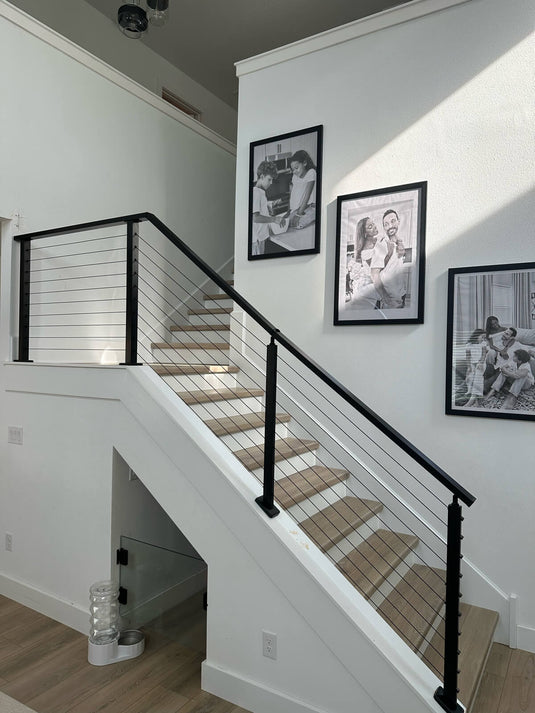TABLE OF CONTENTS
Muzata Stylish Deck Railings for Restaurant Terraces
Spring in March is the perfect time to focus on outdoor spaces. For restaurant owners, spring is not only an opportunity to refresh their decor but also a critical moment to attract customers and enhance their dining experience. With the rainy season in full swing, designing a restaurant terrace that is pleasing and functional becomes a priority for designers, architects, and commercial clients. So if you have the thought of renovating your cable deck railing curb appeal, Muzata is quite a good choice.

Photo credit: Muzata customer
💡This blog will explore innovative "deck rail ideas" to help create a unique and inviting terrace dining space while meeting your practical needs of commercial buildings. Let's get started!
Outdoor Aesthetics and Safety: Simple and Functional Cable Deck Railings
Spring is the ideal season for outdoor activities, and restaurant terraces, as key spaces for dining and socializing, require thoughtful design and safety considerations. Among the many "deck rail ideas," cable deck railings stand out for their minimalist design and exceptional functionality, making them a popular choice for commercial spaces.

Photo credit: Muzata customer

Photo credit: Muzata customer
The standout feature of cable railings is their transparency. Unlike traditional solid railings, Muzata cable railings use thin steel cables as the primary material, providing necessary safety while maximizing unobstructed views. For restaurant terraces, this means diners can enjoy breathtaking outdoor scenery—whether it’s a city skyline or a natural landscape—without visual barriers. This railing design is particularly suitable for restaurants located in high-rise buildings or scenic areas, significantly enhancing the dining experience.

Photo credit: Gary Rupe / Muzata customer
Additionally, cable railings are highly durable, making them ideal for the rainy spring season. Muzata high-quality stainless cables are treated to resist rust and corrosion, ensuring long-term use even in damp conditions. For commercial clients, this translates to lower maintenance costs and a higher return on investment. The minimalist style of cable railings also blends seamlessly with various architectural designs, whether modern, industrial, or traditional, offering versatile solutions for any restaurant terrace.

Photo credit: Lufei Lin / Muzata customer
DIY Projects and Durability: The Commercial Value of Custom Railing Designs
Spring is not only a time for renewal but also an excellent opportunity for DIY projects. For restaurant owners, custom railing designs can elevate the uniqueness of their terrace while serving as a standout feature to attract customers. In the realm of "railing design," customization is becoming a growing trend, especially in commercial spaces, where unique deck rails can add brand personality and charm.


Photo credit: Muzata customer
For example, combining wooden and metal in railing designs offers a blend of natural warmth and modern sophistication. Wood can be stained or painted to match the restaurant’s overall theme, while metal components, such as stainless steel or aluminum, ensure durability in rainy spring conditions. Additionally, incorporating brand elements like logos or signature patterns into the railing design can further enhance brand recognition.
For designers and architects, custom railing designs present both a creative challenge and an opportunity to add commercial value. With thoughtful design, railings can transcend their functional role and become decorative highlights. For instance, integrating embedded lighting systems into railings can create a romantic ambiance for evening dining. Alternatively, adding small planter boxes to railings and filling them with spring flowers can bring a touch of nature to the terrace.

Photo credit: nuhuecompany / Muzata customer
Commercial Integration: Multi-Functional Railing Designs
In commercial spaces, railings can serve more than just a functional purpose. Through innovative design, they can be transformed into multi-functional elements that add significant value to the business. For restaurant terraces, porch rails can act as versatile space dividers, creating distinct dining areas while maintaining an open and cohesive atmosphere.

Photo credit: Muzata customer
For example, DIY railing systems can be designed to adapt to different event needs, allowing for flexible space configurations. During the day, railings can serve as standard safety barriers, while at night, sections with different decorations such as LED strips can be converted into bar counters or display stands, offering customers an interactive experience. This design not only maximizes space utilization but also adds an element of novelty, encouraging repeat visits.

Photo credit: James Mok / Muzata customer
The Bottom Line
In conclusion, spring is the perfect time to revitalize restaurant terraces, and railings, as a crucial component of terrace design, play a significant role in ensuring safety, enhancing dining experiences, and reinforcing brand identity. By exploring innovative "deck rail ideas" mentioned above, designers, architects, and commercial clients can create stunning and practical dining spaces. We welcome your reviews on our products or services! If you have any concerns, please feel free to contact us. We will offer a range of cable railing solutions.
With Muzata durable materials and thoughtful designs suited for the rainy spring season, restaurant terraces can become a lasting attraction, offering customers a memorable dining experience while driving business success. Join us!
📌Ready to elevate your restaurant terrace? Explore Muzata durable and stylish deck rail solutions today and create a dining experience your customers will love! Shop Now!
FAQs
1. What is code for needing a railing on a deck?
Decks higher than 30″ off the ground must have guardrails to satisfy a majority of local building codes. Most U.S. guidelines require railings at least 36″ tall between the decking and top rail, though this varies by location. California requires 42″ or taller railings for decks.
2. What is the most budget-friendly way to do deck railing?
Wood stands out as one of the most affordable choices, while aluminum and steel bring durability with a sleek, modern vibe. Vinyl and composite railings offer a timeless, low-maintenance option that's built to withstand the elements.
3. What can I use instead of deck railings?
Consider stainless-steel cables, metal tubes, or composite railings if you're looking for low-maintenance alternative to wood balusters and railings for your deck.
4. Is cable railing cheaper than wood?
Though their initial cost is higher than wood railings, you'll likely save money in the long run because they don't need to be stained or sealed.
5.How long do cable railings last?
Cable railing is durable and long-lasting compared to other railing systems. It comes with a lifespan of 20 to 30 years and is a worthy investment for your home or other project. Of course, the better you maintain your cable railing system, the longer lifespan you'll get out of it.




